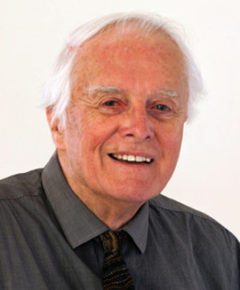Supporter spotlight
Derek F. Wrigley,OAM, LFDIA, FRAIA, ARIBA, DA
A passion for solar power and a love of simple, functional design are what have driven Derek Wrigley throughout his long and distinguished career. Best known as an architect, Derek has also designed furniture, interiors, and landscapes, as well as pioneering the use of solar power in house design.
An ACF member since 1989, Derek was born in the UK. He studied architecture and town planning at Manchester University, before emigrating to Australia in 1947. He first lived in Sydney, where he worked as a lecturer at the NSW University of Technology. Here he established Australia’s first building science course and designed and built his first two solar passive houses.
In 1957, he was invited to work at the Australian National University in Canberra with Fred Ward, a ‘pioneer in furniture design’ about whom Derek is now writing a book.
A trip around the world in 1965 to study design of universities stimulated Derek to develop the concept of ‘total design’ – the integration of all the design disciplines toward a coordinated end result. As ANU’s University Architect he put these ideas into practice, taking responsibility for the design integration of ANU’s architecture, siteplanning, interiors and furniture design, graphics, and landscaping.
As an architect and industrial designer, Derek has a passion for the simple and the functional. “I’ve never tried to create stylised architecture – I don’t see the need in just trying to be different, with lots of superficial irrelevancies. I was trained in the Bauhaus tradition, believing that any object has an inherent and irreducible beauty of its own – it’s a designer’s job to find it.”
His interest in the environment grew slowly, a by-product of his keen interest in the art (and science) of design and a belief in continuous improvement – “ there is always a better way.” After the oil shocks of 1973 and concerned about the need for better design of buildings to utilise natural energies, he founded the New Millwrights collective of like-minded professionals. Since then, Derek has designed and built several solar houses in Sydney and Canberra.
These days, Derek is concerned that the housing industry “…is not taking notice of the problems of the world – builders use the same old conventional way of building houses, with little thought for the people who have to live in them… or for the environment, It is rare to see a spec house with a hot water absorber on its roof, or a single bit of shading over the windows -this is unforgiveable in the light of what is happening to our environment”.
Although Derek is a widely respected expert in his field, he believes his ACF membership adds credibility to his message. “ACF is a good, central voice for many thousands of people all around Australia. On my own, I’m a lone voice in the wilderness – our governments show little interest in listening to individuals.”
His current house is a triumph of retrofitting, showing how just a few simple modifications can help to make a dwelling more self-reliant – and more pleasant to live in. He has grid connected solar panels and says proudly: “This year we’ve generated 102% of the electricity we’ve used!” Keeping waste to a minimum is another achievement. “Apart from recycled materials the only resource that leaves our house comes from our two WCs!”
A keen concern for the future is what keeps Derek so interested in sustainable design issues. “It is no good just talking, writing or reading about sustainability. It requires us to do something toward that critical and vital end point – a sustainable world – so that we can all look our grandchildren in the eye with something like a clear conscience.”
Derek Wrigley’s simple modifications helped to make his solar passive home more effective :
- Derek initiated a system of reflectors on the southern side of the house to add “sunlight and cheerfulness” to previously dark, cold and gloomy rooms
- He also installed a heliostat reflector, which ensures that the sun always enters at 90 degrees through a southern window
- Vents in the ceiling and roof, opened and closed using string and screweyes, cool the house in summer without the need for an airconditioner, ensuring that cool air enters from the shady garden to cool the house structure overnight

